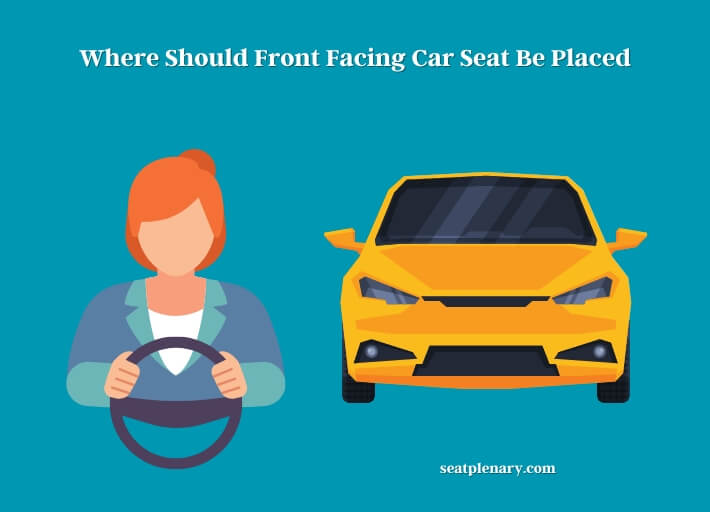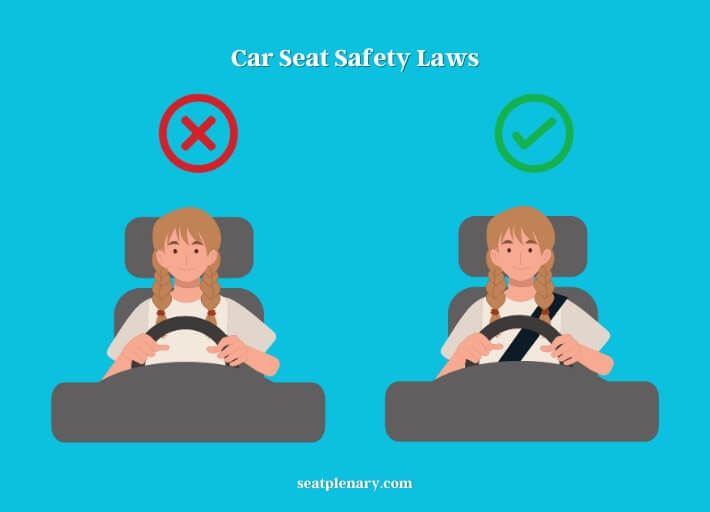Child safety on the road is a paramount concern for every parent. There are numerous safety measures one must take, and one of the most critical is correctly placing a child’s car seat. But when it comes to front-facing car seats, where should they be placed for optimal safety? The answer is not always clear-cut and depends on various factors. In this guide, we’ll delve into the critical aspects of front-facing car seat placement.

Understanding Car Seat Basics
Before we get to the meat and potatoes of front-facing car seat placement, it’s crucial to have a solid foundation of car seat basics.
Why are Car Seats Necessary?
Car seats are designed to protect children during a collision by distributing the forces of the crash across the strongest parts of their bodies. For infants and toddlers, these areas are the back and head. As they grow older, the strongest parts shift to the hips and shoulders.
Types of Car Seats
There are generally three types of car seats: rear-facing, front-facing, and booster seats. Your child’s age, weight, and height determine the kind of car seat you should use.
Transitioning to a Front-Facing Car Seat
When is the right time to transition to a front-facing car seat? This transition is a significant milestone, but how can you be sure it’s the right time?
The Right Age and Size for Front-Facing Car Seats
Every child grows at a different pace, but generally, kids are ready for a front-facing car seat when they exceed the height or weight limit of their rear-facing seat, typically around the age of two. It’s best to keep your child in a rear-facing seat for as long as possible, as they provide better protection for the head, neck, and spine.
Where Should Front Facing Car Seat Be Placed?
Determining where to place a front-facing car seat can feel like navigating a maze. While the vehicle’s manual and the car seat instructions provide guidance, they often don’t give a definitive answer. So, let’s explore some more about the best position for a front-facing car seat.
The Safest Spot for a Front-Facing Car Seat
Statistically, the safest spot for any car seat is the center of the rear seat. Why is this spot considered the safest? Primarily because it’s the furthest from potential impact during a crash. The center position is away from the doors and thus, somewhat protected from side impacts, which can be particularly harmful.
There’s a catch. Not all vehicles allow for car seats to be installed in the middle. Also, some cars have a ‘hump’ in the center seat, which can make car seat installation difficult and unstable. So, while the center seat is the safest, it might not always be feasible or practical.
Alternatives if Center Positioning Isn’t Possible
If the center of the rear seat isn’t a viable option, the next best position for a front-facing car seat is the outboard seats (the ones closest to the doors). Both passenger and driver-side positions are safe, and you can choose based on convenience.
But, if you have a choice between the two outboard seats, you might consider the passenger-side rear seat for a simple reason: curb side loading and unloading. This positioning helps you avoid the dangers of standing between traffic and your car while getting your child in and out of the car seat.
Proper Installation of Front-Facing Car Seats
Securing your child’s front-facing car seat correctly can mean the difference between safety and risk in the event of a crash. Let’s take a more detailed look at the essential steps.

Securing the Car Seat – LATCH vs. Seat Belt
Two primary methods can be used to secure a front-facing car seat – the vehicle’s seat belt or the LATCH system. Both methods are equally safe when used correctly, so it comes down to which one you find easier and what your vehicle supports.
LATCH, which stands for Lower Anchors and Tethers for CHildren, is a system designed to make car seat installation easier. Instead of using a seat belt to secure the car seat, it uses anchors found in the vehicle’s seat crack (where the back meets the bottom) and a top tether.
On the other hand, if your vehicle doesn’t have LATCH, or if the car seat is positioned where the LATCH isn’t accessible, you can use the vehicle’s seat belt to secure the car seat. Just make sure to lock the seat belt as per the vehicle’s manual.
Positioning the Car Seat at the Correct Angle
Front-facing car seats should be installed so that they are upright or slightly reclined. Each car seat will have a level or line on it indicating the correct angle.
Tightening and Checking the Car Seat
Once you’ve hooked or belted the car seat in, you’ll need to tighten it down. A properly installed car seat shouldn’t move more than one inch side-to-side or front-to-back when checked at the belt path.
Using the Tether Strap
A crucial part of installing a front-facing car seat is using the tether strap. The tether strap is a belt on the top back of the car seat that attaches to a tether anchor in your vehicle. This strap prevents the car seat and the child’s head from moving too far forward in a crash, reducing the risk of head injury.
Considerations for Older Children
As children grow older, they’ll eventually graduate from front-facing car seats. But when is the right time, and what are the next steps? Here, we’ll address the critical factors to consider as your child continues to grow.
Transitioning to a Booster Seat
When your child outgrows the maximum height or weight limit of their front-facing car seat, it’s time for a booster seat. Booster seats ‘boost’ your child up so the vehicle’s seat belt fits correctly. It should lay across the strongest parts of your child’s body: the middle of the chest and shoulder, and across the upper thighs.
It’s crucial to read the booster seat instructions and your vehicle’s owner manual to ensure proper fit and installation.
Moving to Vehicle Seat Belt Alone
The transition from a booster seat to just using the vehicle’s seat belt is another significant milestone. Your child is ready for this step when they are tall enough so that the seat belt fits them correctly without a booster seat, usually when they are 4 feet 9 inches tall and between 8 and 12 years old.
When is it Safe to Move to the Front Seat?
While the back seat is always safer for children, eventually, your child will want to move to the front. Safety experts recommend that children should be at least 13 years old before they sit in the front seat. This age is based on the average child’s height and weight, as well as the potential risk of injury from the airbag if it deploys in a crash.
Car Seat Safety Laws
It’s essential to adhere to car seat safety laws. They’re designed to protect children, and they provide a legal basis for safe transportation. These laws vary by state and country, but they have common features.
Age, Weight, and Height Guidelines
Most car seat laws reference age, weight, and height guidelines for when to transition between car seat types. For example, laws might mandate that children under a certain age or weight must use a rear-facing car seat.
Placement Laws
Some laws dictate where in the vehicle child seats should be placed. Most often, they require that child seats are placed in the rear of the vehicle.
Penalties for Non-Compliance
Non-compliance with car seat safety laws can result in a variety of penalties. These typically involve fines, but more serious or repeated offences may result in more severe consequences, such as points on your license or the requirement to attend an educational course on child safety.

It’s essential to check the specific car seat laws in your state or country to ensure you’re not only keeping your child safe but also staying on the right side of the law. Keep in mind that law enforcement officers see compliance with car seat laws as a critical part of road safety and routinely look out for violations.
Frequently Asked Questions (FAQs)
How do I know when to transition to a front-facing car seat?
Generally, children are ready for a front-facing car seat when they exceed the height or weight limit of their rear-facing seat, typically around the age of two. However, it’s best to keep them in a rear-facing seat for as long as possible, as they provide better protection.
Where should a front-facing car seat be placed?
The safest place for a front-facing car seat is the center of the rear seat. However, not all cars can safely accommodate a car seat in this position.
How should a front-facing car seat be installed?
The car seat should be tightly secured and not move more than one inch side-to-side or front-to-back when checked at the belt path. Always use the top tether to limit forward movement in a crash.
When can my child switch from a car seat to a booster seat?
When your child outgrows their front-facing car seat, it’s time to switch to a booster seat.
When can my child sit in the front seat?
Most safety experts agree that children should be at least 13 years old before they sit in the front seat.
What are the penalties for not adhering to car seat laws?
Penalties vary by state and country but can include fines, points on your driver’s license, and required attendance at an educational program.
Conclusion
Understanding where a front-facing car seat should be placed can significantly enhance your child’s safety on the road. It’s a mix of adhering to legal requirements and tailoring your approach to your vehicle and child’s needs. Remember, the safest place for your child’s car seat is in the rear center seat, and it should always be properly installed and secured.
Read more:
